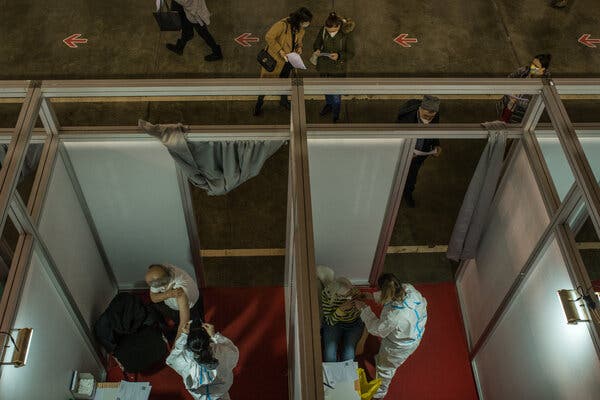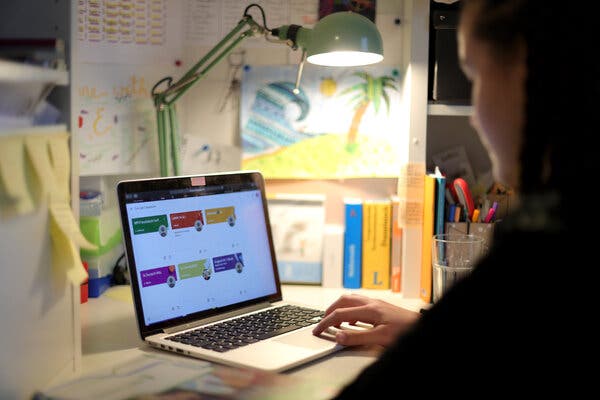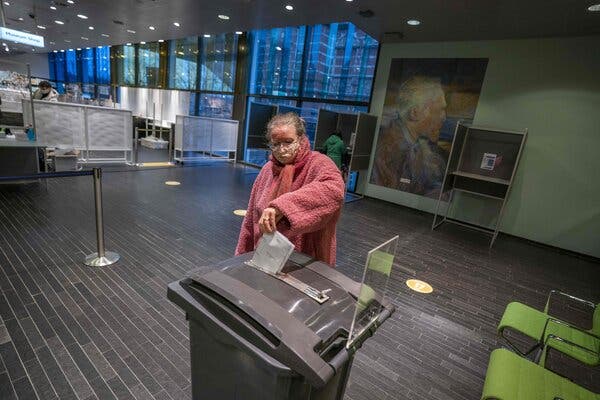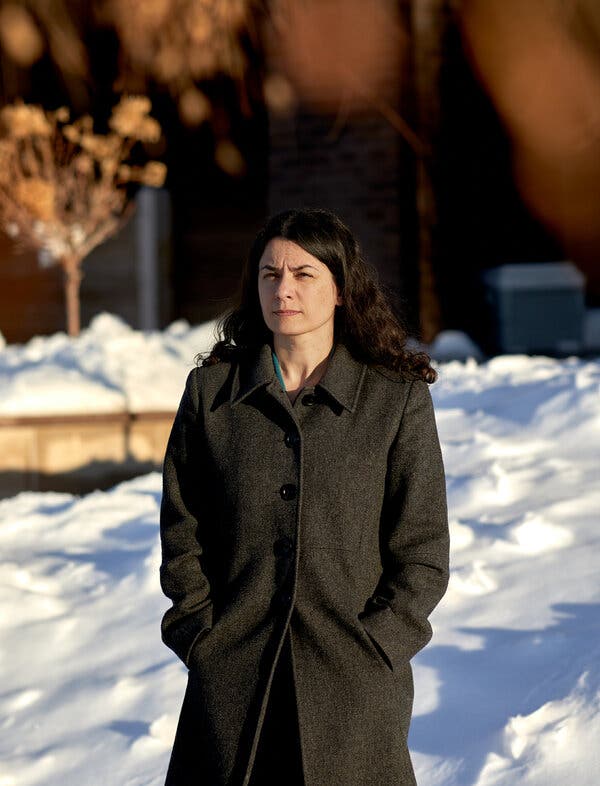Not long ago, Covid-19 vaccines were available only to the most vulnerable Americans and some essential workers. That is quickly changing as vaccine production and distribution ramp up and more states begin to heed a call from President Biden to expand access to all adults by May.
States are also racing to stay ahead of the growing number of virus variants, some of which are more contagious and possibly even more deadly. At least three states — Maine, Virginia and Wisconsin — and Washington, D.C., have said that they will expand eligibility to their general population by May 1, the deadline that Mr. Biden set last week. At least six other states — including Colorado, Connecticut, Ohio, Michigan, Montana and Utah — hope to do so this month or next.
In Mississippi and Alaska, everyone age 16 or older is eligible, and Arizona and Michigan have made the vaccines available to all adults in some counties.
Mr. Biden said last week that he was directing the federal government to secure an additional 100 million doses of the Johnson & Johnson vaccine. With three vaccines now in use, Mr. Biden has said that the United States will have secured enough doses by the end of May for shots to be available for all adults.
Several states have already been expanding eligibility for vaccinations. In Ohio, vaccines will open to anyone 40 and up as of Friday, and to more residents with certain medical conditions. Indiana extended access to people 45 and older, effective immediately.
Coloradans age 50 and up will be eligible for a shot on Friday, along with anyone 16 years and older with certain medical conditions. Wisconsin said on Tuesday that residents 16 years and up with certain medical conditions would be eligible a week earlier than initially planned.
On Monday, Texans age 50 and older and Georgians over 55 became eligible for vaccines.
In New York State, residents 60 and older are eligible to receive a vaccine, and more frontline workers will become eligible on Wednesday, including government employees, building services workers and employees of nonprofit groups. Gov. Andrew M. Cuomo has yet to announce how or when the state will open eligibility to all adults.
Since vaccinations began in December, the federal government has delivered nearly 143 million vaccine doses to states and territories, and more than 77 percent have been administered, according to Centers for Disease Control and Prevention. The country is averaging about 2.4 million shots a day, compared with well under one million a day in January.
As of Tuesday, 65 percent of the country’s older population had received at least one vaccine dose, according to C.D.C. data, with 37 percent fully vaccinated.
Virus-related cases, deaths and hospitalizations are significantly down from the peak levels reported in January. But progress has slowed noticeably since the start of this month, with continued drops in some states offset by persistent outbreaks in other parts of the country, especially the Northeast.
Public health leaders like Dr. Rochelle Walensky, the C.D.C. director, have warned Americans not to let their guard down prematurely, noting that the amount of new cases remains high, at around 55,000 per day.

Stained for years by its brutal role in the horrific Balkan conflicts of the 1990s, Serbia is now basking in the glow of success in a good campaign: the quest to get its people vaccinated.
Serbia has raced ahead of the far richer and usually better-organized countries in Europe to offer all adult citizens not only free inoculations, but also a smorgasbord of five vaccines to choose from.
The country’s unusual surfeit of vaccines has been a public relations triumph for the increasingly authoritarian government of President Aleksandar Vucic. It has burnished his own and his country’s image, weakened his already beleaguered opponents and added a new twist to the complex geopolitics of vaccines.
Serbia, with a population under seven million, placed bets across the board, sealing initial deals for more than 11 million doses with Russia and China, whose products have not been approved by European regulators, as well as with Western drug companies.
It reached its first vaccine deal, covering 2.2 million doses, with Pfizer in August and quickly followed up with contracts for millions more from Russia and China.
As a result, Serbia has become the best vaccinator in Europe after Britain, data collected by OurWorldInData shows. It had administered 29.5 doses for every 100 people as of last week compared with just 10.5 in Germany, a country long viewed as a model of efficiency and good governance, and 10.7 in France.
Serbia’s prime minister, Ana Brnabic, attributed her country’s success to its decision to “treat this as a health issue, not a political issue. We negotiated with all, regardless of whether East or West.”
Serbia’s readiness to embrace non-Western vaccines so far shunned by the European Union could backfire if they turn out to be duds. Sinopharm, unlike Western vaccine makers, has not published detailed data from Phase 3 trials. Data it has released suggest that its product is less effective than Western coronavirus vaccines.
Many Serbians, apparently reassured by the vaccination drive, have also lowered their guard against the risk of infection. The daily number of new cases has more than doubled since early February, prompting the government to order all businesses other than food stores and pharmacies to close last weekend.

After a tough year of toggling between remote and in-person schooling, many students, teachers and their families feel burned out from pandemic learning. But companies that market digital learning tools to schools are enjoying a windfall.
Venture and equity financing for education technology start-ups has more than doubled, surging to $12.6 billion worldwide last year from $4.8 billion in 2019, according to a report from CB Insights, a firm that tracks start-ups and venture capital.
Yet as more districts reopen for in-person instruction, the billions of dollars that schools and venture capitalists have sunk into education technology are about to get tested.
“There’s definitely going to be a shakeout over the next year,” said Matthew Gross, the chief executive of Newsela, a popular reading lesson app for schools.
A number of ed-tech start-ups reporting record growth had sizable school audiences before the pandemic. Then last spring, as school districts switched to remote learning, many education apps hit on a common pandemic growth strategy: They temporarily made their premium services free to teachers for the rest of the school year.
“What unfolded from there was massive adoption,” said Tory Patterson, a managing director at Owl Ventures, a venture capital firm that invests in education start-ups like Newsela. Once the school year ended, he said, ed-tech start-ups began trying to convert school districts into paying customers, and “we saw pretty broad-based uptake of those offers.”
Some consumer tech giants that provided free services to schools also reaped benefits, gaining audience share and getting millions of students accustomed to using their product.
The worldwide audience for Google Classroom, Google’s free class assignment and grading app, has skyrocketed to more than 150 million students and educators, up from 40 million early last year. And Zoom Video Communications says it has provided free services during the pandemic to more than 125,000 schools in 25 countries.
Whether tools that teachers have come to rely on for remote learning can maintain their popularity will now hinge on how useful the apps are in the classroom.
GLOBAL ROUNDUP

As Dutch voters go to the polls for parliamentary elections this week, the pandemic has changed the usual dynamic.
To help maintain social distancing, the voting process was spread over three days, ending on Wednesday. Voters over 70 were encouraged to vote by mail. And campaigning mainly took place on television, making it hard for voters to spontaneously confront politicians as is typical practice.
Coronavirus cases are again surging in the Netherlands, prompting the authorities to warn of a third wave. Last year, it took the government of Prime Minister Mark Rutte until November to get the country’s testing capabilities in order, and the vaccination process is also going slowly.
Yet during the campaigning, more localized issues managed to overshadow the government’s handling of the coronavirus.
The prime minister and his cabinet resigned in January over a scandal involving the tax authorities’ hunting down people, mostly poor, who had made administrative mistakes in their child benefits requests. Many were brought to financial ruin as a result.
Broader policies put forward by Mr. Rutte, who has been in power since 2010, were also a focus on the campaign trail. While his party is ahead in the polls, it has lost some support in recent weeks.
Neighboring Germany is also entering a packed election season, with national and state votes coming in a year that will bring to an end the 16-year chancellorship of Angela Merkel.
In other developments around the world:
-
Australia will send 8,000 coronavirus vaccine doses to Papua New Guinea in an attempt to curb a rapidly growing outbreak in the country, which is Australia’s closest neighbor, Prime Minister Scott Morrison said on Wednesday. Australia will also ask AstraZeneca to divert to the small island nation a million vaccine doses that were bound for Australia. And it is suspending all charter flights from Papua New Guinea, where about half of the nation’s total reported 2,351 coronavirus cases have been recorded in the past two weeks.

When the pandemic narrowed the world, Jonathan Hirshon stopped traveling, eating out, going to cocktail parties and commuting to the office.
What a relief.
Mr. Hirshon experiences severe social anxiety. Even as he grieved the pandemic’s toll, he found lockdown life to be a respite.
Now, with public life about to resume, he finds himself with decidedly mixed feelings — “anticipation, dread and hope.”
Mr. Hirshon, a 54-year-old public relations consultant, is one of numerous people who find the everyday grind not only wearing, but also emotionally unsettling. That includes people with clinical diagnoses of anxiety and obsessive compulsive disorder, and also some run-of-the-mill introverts.
A new survey from the American Psychological Association found that while 47 percent of people have seen their stress rise over the pandemic, about 43 percent reported no change in stress and 7 percent said they felt less stress.
Mental health experts said that this portion of the population found lockdown measures protective, a sort of permission to glide into more predictable spaces, schedules, routines and relationships. And experts say that while the lockdown periods have blessed the “avoidance” of social situations, the circumstances are poised to change.
“I am very worried about many of my socially anxious patients,” said Andrea Maikovich-Fong, a psychologist in Denver. That anxiety, she said, “is going to come back with a vengeance when the world opens up.”

This year perhaps more than ever, the college essay has served as a canvas for high school seniors to reflect on a turbulent and, for many, sorrowful year. It has been a psychiatrist’s couch, a road map to a more hopeful future, a chance to pour out intimate feelings about loneliness and injustice.
In response to a request from The New York Times, more than 900 seniors submitted the personal essays they wrote for their college applications. Reading them is like a taking a trip through two of the biggest news events of recent decades: the devastation wrought by the coronavirus, and the rise of a new civil rights movement.
In the wake of the high-profile deaths of George Floyd and Breonna Taylor at the hands of police officers, students shared how they had wrestled with racism in their own lives. Many dipped their feet into the politics of protest.
And in the midst of the most far-reaching pandemic in a century, they described the isolation and loss that have pervaded every aspect of their lives since schools suddenly shut down a year ago. They sought to articulate how they have managed while cut off from friends and activities.
The coronavirus was the most common theme in the essays submitted to The Times, appearing in 393 essays, more than 40 percent. Next was the value of family, coming up in 351 essays, but often in the context of other issues, like the pandemic and race. Racial justice and protest figured in 342 essays.
Family was not the only eternal verity to appear. Love came up in 286 essays; science in 128; art in 110; music in 109; and honor in 32. Personal tragedy also loomed large, with 30 essays about cancer alone.
Some students resisted the lure of current events and wrote quirky essays about captaining a fishing boat on Cape Cod or hosting dinner parties. A few wrote poetry. Perhaps surprisingly, politics and the 2020 election were not of great interest.






